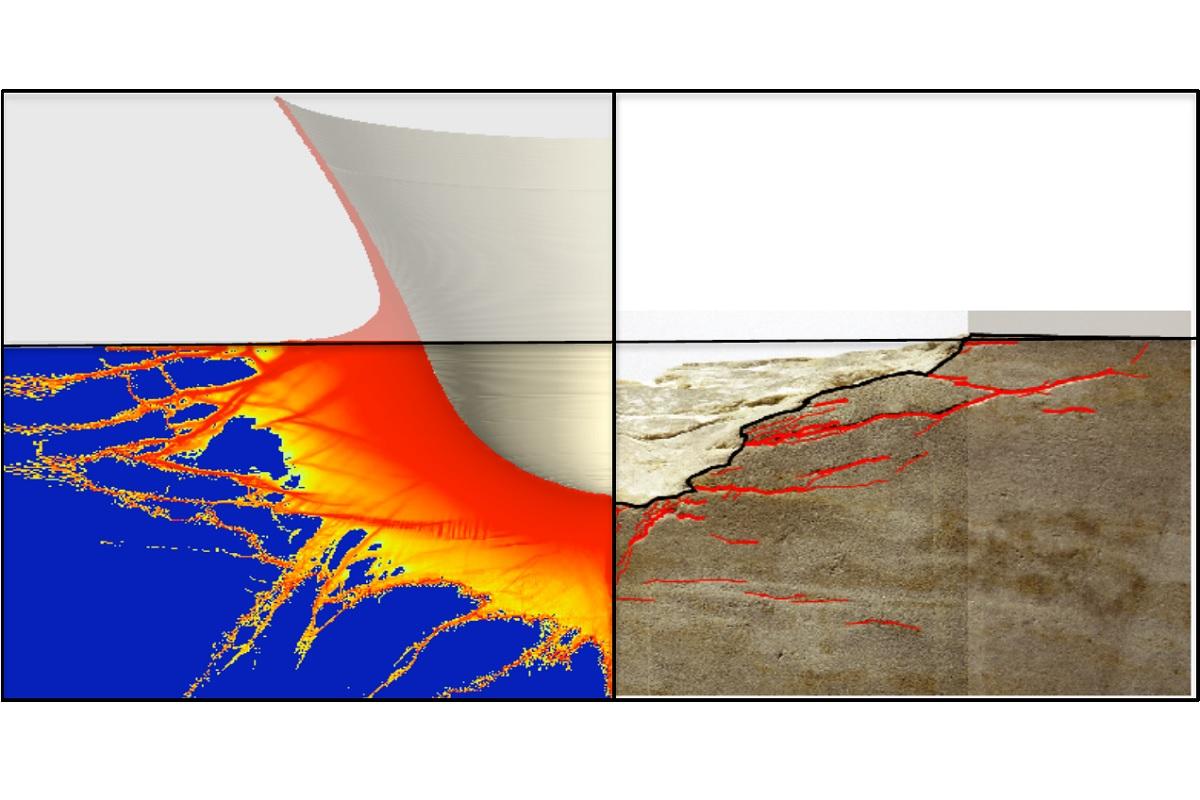Numerical modelling of impact processes plays a central role in the framework of the MEMIN research network. The simulation of impacts provides insights into highly dynamic processes that are impossible or rather difficult to measure. With regard to the exploration of natural craters on Earth and other planetary surfaces computer models are the only viable approach to simulate the crater formation process. The goal of this study is to improve the existing simulation software by implementing novel, more sophisticated material models that describe the behaviour of matter under extreme pressure, temperature and strain rate conditions. Besides model development validation and calibration, using the laboratory experiments is crucial for realistic model predictions on crater size, ejecta distribution, damage and fracturing of rocks. Two different model types, so-called (1) “meso-scale” and (2) “macro-scale” models are employed:
- Meso-scale models enable to resolve heterogeneities in rocks on a meso-scale such as pores and grains. The models allow for a detailed analysis of modifications of the meso-scale structure as a consequence of shock wave loading, in other words, for example, how pores collapse and how it affects the shock pressure distribution.
- In macro-scale models the entire crater formation process is simulated. Results from meso-scale models are take into account for the macro-scale consequences. These models are directly comparable to observations from laboratory experiments with regard to crater size, ejecta distribution, and the extent of the damage zone. In addition seismic signals and the propagation of the shock wave can be recorded and compared with experimental measurements using acoustic sensory and pressure gauges.
By integrated meso- and macro-scale modelling and the calibration od material models by means of laboratory experiments it is possible to reconstruct the formation of natural craters in a size range of a few 100 metres to more than 1,000 kilometeres.
Funding: Deutsche Forschungsgemeinschaft (DFG)
Duration: 08/2013 – 10/2016
Project website: http://www.memin.de/
Publications:
- Wünnemann K., Zhu Meng-Hua, Stöffler D. 2015, Impacts into Quartz Sand: Crater Formation, Shock Metamorphism, and Ejecta Distribution in Laboratory Experiments and Numerical Models, Meteoritics & Planetary Science.
- Kowitz A. , Güldemeister N., Schmitt R. T., Reimold W. U., Wünnemann K. 2016. Revision and recalibration of existing shock classifications for quartzose rocks using low-shock pressure (2.5-20 GPa) recovery experiments and meso-scale numerical modeling. Meteoritics & Planetary Science 51(10), 1741-1761.
- Güldemeister N., Wünnemann K. and Poelchau M. H. 2015. Scaling impact crater dimensions in cohesive rock by numerical modeling and laboratory experiments. Geological Society of America Special Papers 518: SPE518-02.
- Moser D., Güldemeister N., Wünnemann K., Grosse C., 2013. Acoustic Emission Analysis of Experimental Impact Processes in Comparison to Ultrasound Measurements and Numerical Modeling. Journal of Acoustic Emission(JAE). Online Volumes 31, 50-66.
- Kowitz A. , Güldemeister N., Reimold W. U., Schmitt R. T., Wünnemann K. , 2013. Diaplectic quartz glass and SiO2 melt experimentally generated at only 5 GPa shock pressure in porous sandstone: Laboratory observations and meso-scale numerical modeling. Earth and Planetary Science Letters 384:17-26, http://dx.doi.org/10.1016/j.epsl.2013.09.021.
- Güldemeister N., Durr N., Wünnemann K., Hiermaier S., 2013. Propagation of impact-induced shock waves in porous sandstone using mesoscale modeling. Meteoritics & Planetary Science 48: 115-133.
- Durr N., Sauer M., Hiermaier S., Güldemeister N., Wünnemann K. 2013. Mesoscale investigation of shock wave effects in dry and water-saturated sandstone. Proceedings of the 12th Hypervelocity Impact Symposium, Procedia Engineering 58: 289–298.
- Buhl E., Kowitz A., Elbeshausen D., Sommer F., Dresen G., Poelchau M. H., Reimold W. U., Schmitt R. T., Kenkmann T. 2013. Particle size distribution and strain rate attenuation in hyper-velocity impact and shock recovery experiments. Journal of Structural Geology, Volume 56, November 2013, Pages 20-33, ISSN 0191-8141, http://dx.doi.org/10.1016/j.jsg.2013.08.007.
- Wünnemann K., Nowka D., Collins G.S., Elbeshausen D., Bierhaus M. 2011. Scaling of impact crater formation on planetary surfaces – insights from numerical modeling. Proceedings of the 11th Hypervelocity Impact Symposium, Fraunhofer Verlag 120: 1-16.
- Kenkmann T., Kowitz A., Wünnemann K., Behner T., Schäfer F., Thoma K., Deutsch A. 2011. Experimental impact cratering in sandstone: the effect of pore fluids. Proceedings of 11th Hypervelocity Impact Symposium, Fraunhofer Verlag 97: 64-74.
- Kenkmann T., Wünnemann K., Deutsch A., Poelchau M. H., Schäfer F, Thoma K. 2011. Impact cratering in sandstone: The MEMIN pilot study on the effect of pore water. Meteoritics & Planetary Science 46: 890–902.
